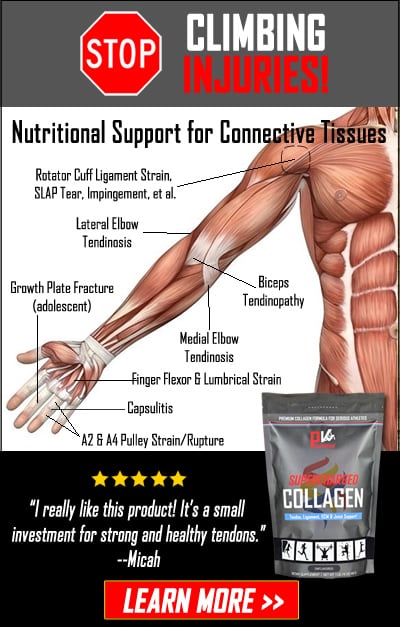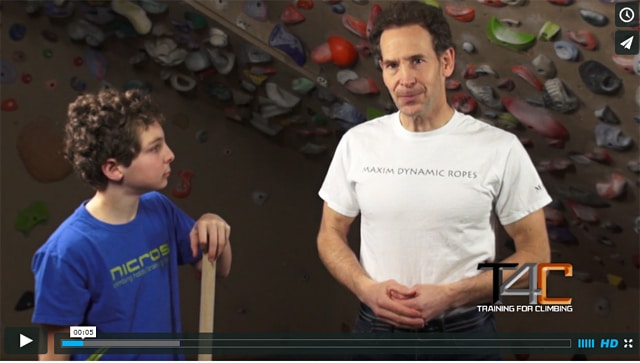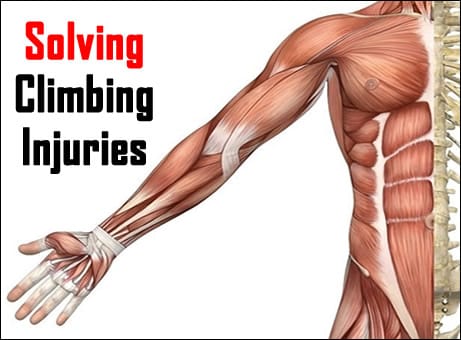Finger pulley tweaks are the most common climbing injury. No one is immune—not beginner, intermediate, nor elite climbers.
The prudent response to a “tweak” (minor pain while crimping) is to take a few weeks off from climbing and, after an initial period of total rest (<7 days), to engage in daily rehab that cautiously loads the finger tendons and ligaments to help spur on proper healing. Daily supplementation with Supercharged Collagen—ideally one hour before rehab—has been shown in research to increase net collagen synthesis in the trained tissues.
Unfortunately, many climbers attempt to “climb through” the injury. The common manta I hear from injured climbers (in a mild state of denial) is “I still have 9 healthy fingers, so I’m going to climb on!” Unfortunately, this approach often results in a worse pulley tear that necessitates a longer break from climbing. Learn more about the common causes of pesky finger pulley injuries in T4C podcast #39.
So what can you do to speed healing of an injured finger pulley?
Appropriate daily physical rehab is important, but so is nutrition! In this video from the popular YouTube channel “Geek Climber”, Eric Hörst describes the prudent approach to hastening recovery from a common finger pulley tweak. (Note: A more significant pulley rupture should be examined by a medical professional, and it is likely best treated initially with a pulley splint.)
Maximizing the synergy of training and nutritional interventions requires proper timing of nutrients and workouts. To provide tenocytes with the necessary amino acids to strengthen structural and force transfer proteins, it’s recommended to consume the vitamin C-enriched hydrolyzed collagen 30 to 60 minutes before training.
Also critical is the length of recovery between rehab sessions. Tendon cell signaling is optimal from brief, targeted workouts, whereas long, hard comprehensive training sessions make the cells refractory (they begin to “turn off” and become somewhat resistant to adaptation). Studies have shown a tendon cell signaling “reset period” of approximately 6 hours. Consequently, two or three brief rehabilitative sessions separated by at least 6 hours is optimal for tissue repair and recovery.
Copyright © 2000–2019 Eric J. Hörst | All Rights Reserved.








![🚨New Training For Climbing podcast drop! [**Link in bio.**]
This a two-part deep dive into designing a comprehensive, long-term systems approach to training. Coach @eric_horst unpacks—in rich detail—how systems actually function, and he highlights how transformative climbers throughout history “shake up the box” with innovative, highly effective methods to achieve big goals and push the boundaries of our sport.
In Part 1 (#122), Eric blends a concise climbing history lesson with an engineer-like breakdown of how intelligent systems operate. Part 2 (#123) of this series will deliver the actionable strategies you can use to build a personalized, high-performance training system for this winter…and for many seasons to come.
Eric emphasizes that as climbers progress beyond the beginner stage, climbing and training grow increasingly complex—requiring intentional, organized, and year-round development of strength, technique, mental skills, recovery habits, nutrition, and lifestyle management. Rather than ad-lib sessions or singular-focus programs (like only training strength), climbers need a comprehensive system fine-tuned daily and seasonally.
This is an entertaining and thought-provoking episode—so lean in, listen closely, and get ready to feel inspired, challenged, and equipped to level-up your modus operandi at the crag, in the gym, at home, and in everything you do! Listen on Apple Podcasts, Spotify, or online using the web player below.
#climbingtraining #bouldering #indoorclimbing #climbing #climbingpodcast #erichorst #trainingforclimbing @lasportivana @physivantage](https://trainingforclimbing.com/wp-content/plugins/instagram-feed/img/placeholder.png)


